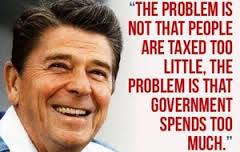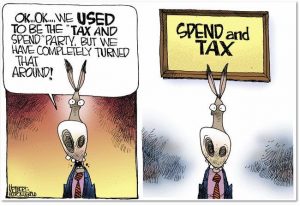TABOR and COVID 19: We’re all gonna pay
 Blog post by Christine Burtt
Blog post by Christine Burtt
5/26/2020 – 4 minute read
Let’s face it. You can’t shut down the economy, borrow trillions of dollars to subsidize households and businesses, and cause massive unemployment in the private sector without getting seriously upside down in tax revenues.
The Colorado state budget will be about $3.3B in the hole for FY2021, and that doesn’t include deficits in county and special district budgets.
If Legislatures over the years had honored the requirement of the Taxpayer’s Bill of Rights to stash away an emergency fund, we’d have roughly $1B in cash right now. Instead of a lockbox of cash, illiquid government buildings were determined to be assets counted toward the emergency fund. Anybody have cash to buy a government building? But I digress….
In the Democrat-controlled Colorado Legislature, raising taxes is the easy answer to a budget shortfall. The short-term exercise is to reconcile what is “essential” vs “nice to have.”
In reality, government mandated services like administering food stamps, running elections, law enforcement, infrastructure, and paying public employee retirement benefits will be protected. But other programs funded for ideological wish-lists may be delayed – until they can raise taxes.
The most likely ways to raise taxes include:
1) Create new categories of taxpayers based on income and assign progressive tax rates;
2) Fiddle with or repeal the Gallagher Amendment to change the proportion of property taxes paid by businesses and residents;
3) Add more “fees” – a popular legislative work-around to avoid asking voters for a tax hike.
The first approach, a new progressive income tax defined in Initiative 271, likely to be on the November ballot, is authored by the left-leaning Colorado Fiscal Institute, the Bell Policy Center, and the Colorado Education Association. It seeks to raise an additional $2 billion each year. It would create four graduated tax brackets, starting with a base rate of 4.58% for 95 percent of taxpayers, increasing to an eye-popping 8.9% for state income tax (plus the federal burden) for the highest-earning households.
It’s sold as “the rich aren’t paying their fair share,” and “children and poor people will suffer” if government can’t pay more employees with cushy retirement packages.
There is no thought to the unintended consequences of driving high-income earners out of Colorado.
It does, however, establish a non-paid 25-member “Fair Tax Review Commission.” Fifty percent of the additional tax monies collected are dedicated to K-12 education – in addition to currently mandated appropriations. Ninety percent of the remainder must be spent to “address the impacts of a growing population and changing economy.” The rest goes for administration.
The language allows all taxes collected in excess of budget caps to be kept by the State to be spent as legislators choose. These extra monies become part of the baseline for the next year’s budget formula, which, according to TABOR will include increases in population and inflation. As the economy improves, the State budget will always expand, regardless of the need for additional government programs.
Countering this effort is Initiative 306 led by the fiscally-conservative Independence Institute. It would reduce the state’s current flat tax income rate from 4.63% to 4.55%.
The biggest difference between these two Initiatives is that #271 puts money into government budgets, while #306 allows taxpayers to keep more of what they earn and direct it to their households, their families, and their charities.
The second approach deals with the Gallagher Amendment. This is the other brake on out-of-control spending by government. One proposal is to change the proportion of total property taxes paid by residents (45%) and businesses (55%) to counties. TABOR sets the guideline for how much government budgets can be; Gallagher sets the proportion of who pays.
The thinking is that because businesses have taken such a hit during the pandemic even while home values have remained relatively strong, more money could be harvested by increasing the percentage paid by homeowners.
Another proposal affecting Gallagher would change how often residential and commercial properties are assessed from the current once every two years to once every four years. That would give some time for businesses and home values to shake-out from the artificial slump caused by the Wu-flu.
The third approach of instituting fees has been pushed on hospitals, vehicle registrations, toll roads, and licenses to do everything from make a living to enjoying the great outdoors. Expect more “fees.”

There’s another way: cut spending. Radical, right? Colorado’s state budget for 2019-2020 was $32.5 billion. We have more than 39,000 state employees. Expenditures generally include spending on government salaries, infrastructure, education, public pensions, public assistance, corrections, Medicaid, and transportation. Within those categories, are all those people and programs really essential to the well-being of Coloradoans?
Initiative 271:
http://www.sos.state.co.us/pubs/elections/Initiatives/titleBoard/filings/2019-2020/271Final.pdf

Leave a Reply